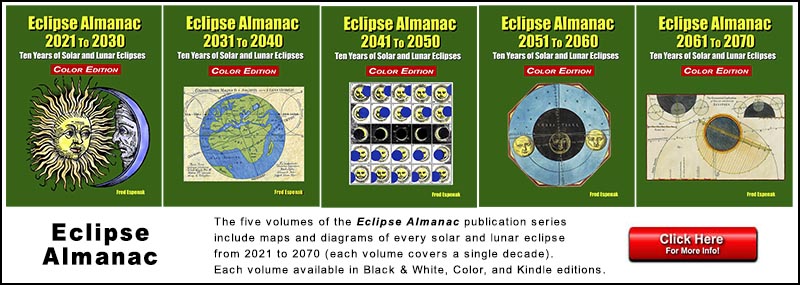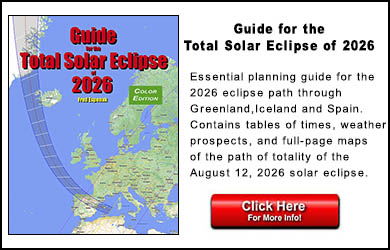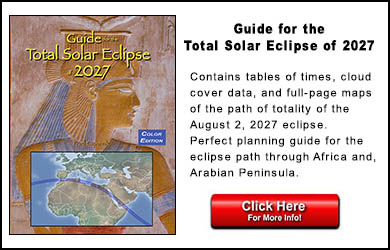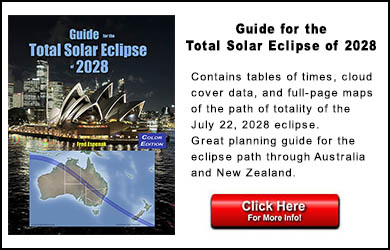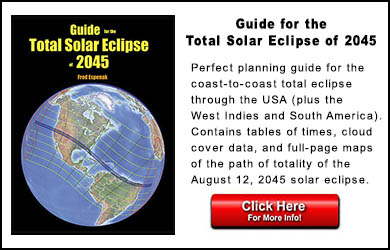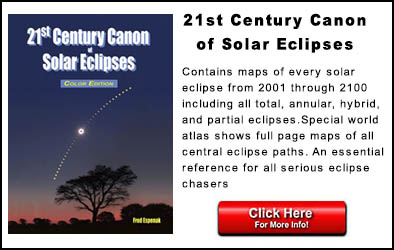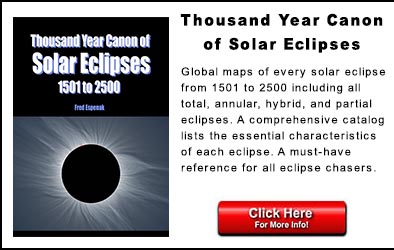Solar Eclipses for Beginners
©2020 by Fred Espenak
Introduction
What is an eclipse of the Sun? What causes eclipses and why? How often do eclipses happen and when is the next eclipse of the Sun? You'll learn the answers to these questions and more in MrEclipse's primer on solar eclipses. Before we learn more about the eclipses of the Sun, we need to first talk about the Moon.
Phases of the Moon
Phases of The Moon
The Moon is a cold, rocky body about 2,160 miles (3,476 km) in diameter. It has no light of its own but shines by sunlight reflected from its surface. The Moon orbits Earth about once every 29 and a half days. As it circles our planet, the changing position of the Moon with respect to the Sun causes our natural satellite to cycle through a series of phases:
- New Moon > New Crescent > First Quarter > Waxing Gibbous > Full Moon >
Waning Gibbous > Last Quarter > Old Crescent > New Moon (again)
The phase known as New Moon can not actually be seen because the illuminated side of the Moon is then pointed away from Earth. The rest of the phases are familiar to all of us as the Moon cycles through them month after month. Did you realize that the word month is derived from the Moon's 29.5 day period?
To many early civilizations, the Moon's monthly cycle was an important tool for measuring the passage of time. In fact many calendars are synchronized to the phases of the Moon. The Hebrew, Muslim and Chinese calendars are all lunar calendars. The New Moon phase is uniquely recognized as the beginning of each calendar month just as it is the beginning on the Moon's monthly cycle. When the Moon is New, it rises and sets with the Sun because it lies very close to the Sun in the sky. Although we cannot see the Moon during New Moon phase, it has a very special significance with regard to eclipses.
Geometry of the Sun, Earth and Moon During an Eclipse of the Sun
The Moon's two shadows are the penumbra and the umbra.
(Sizes and distances not to scale)
The Moon's Two Shadows
An eclipse of the Sun (or solar eclipse) can only occur at New Moon when the Moon passes between Earth and Sun. If the Moon's shadow happens to fall upon Earth's surface at that time, we see some portion of the Sun's disk covered or 'eclipsed' by the Moon. Since New Moon occurs every 29 1/2 days, you might think that we should have a solar eclipse about once a month. Unfortunately, this doesn't happen because the Moon's orbit around Earth is tilted 5 degrees to Earth's orbit around the Sun. As a result, the Moon's shadow usually misses Earth as it passes above or below our planet at New Moon. At least twice a year, the geometry lines up just right so that some part of the Moon's shadow falls on Earth's surface and an eclipse of the Sun is seen from that region.
The Moon's shadow actually has two parts:
- The Moon's faint outer shadow.
- Partial solar eclipses are visible from within the penumbral shadow.
- The Moon's dark inner shadow.
- Total solar eclipses are visible from within the umbral shadow.
1. Penumbra
2. Umbra
When the Moon's penumbral shadow strikes Earth, we see a partial eclipse of the Sun from that region. Partial eclipses are dangerous to look at because the un-eclipsed part of the Sun is still very bright. You must use special filters or a home-made pinhole projector to safely watch a partial eclipse of the Sun (see: Observing Solar Eclipses Safely).
What is the difference between a solar eclipse and a lunar eclipse? A lunar eclipse is an eclipse of the Moon rather than the Sun. It happens when the Moon passes through Earth's shadow. This is only possible when the Moon is in the Full Moon phase. For more information, see Lunar Eclipses for Beginners.
Total Solar Eclipse and Path of Totality
Total Solar Eclipses and the Path of Totality
If the Moon's inner or umbral shadow sweeps across Earth's surface, then a total eclipse of the Sun is seen. The track of the Moon's umbral shadow across Earth is called the Path of Totality. It is typically 10,000 miles long but only about 100 miles wide. It covers less than 1% of Earth's entire surface area. In order to see the Sun become completely eclipsed by the Moon, you must be somewhere inside the narrow path of totality.
The path of a total eclipse can cross any part of Earth. Even the North and South Poles get a total eclipse sooner or later. Just one total eclipse occurs each year or two. Since each total eclipse is only visible from a very narrow track, it is rare to see one from any single location. You'd have to wait an average of 375 years to see two total eclipses from one place. Of course, the interval between seeing two eclipses from one particular place can be shorter or longer. For instance, the last total eclipse visible from Princeton, NJ was in 1478 and the next is in 2079. That's an interval of 601 years. However, the following total eclipse from Princeton is in 2144, after a period of only 65 years.
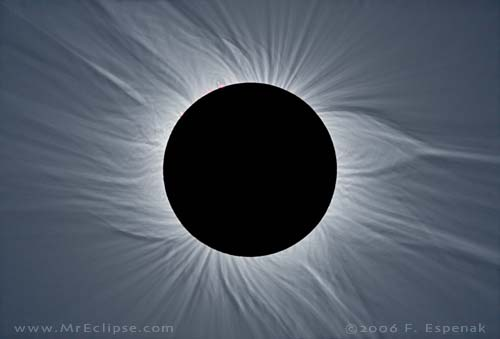
2006 Total Solar Eclipse
A composite image reveals subtle structure in the Sun's corona.
(click to see more photos)
Awesome Totality
The total phase of a solar eclipse is very brief. It rarely lasts more than several minutes. Nevertheless, it is considered to be one of the most awe inspiring spectacles in all of nature. The sky takes on an eerie twilight as the Sun's bright face is replaced by the black disk of the Moon. Surrounding the Moon is a beautiful gossamer halo. This is the Sun's spectacular solar corona, a super heated plasma two million degrees in temperature. The corona can only be seen during the few brief minutes of totality. To witness such an event is a singularly memorable experience which cannot be conveyed adequately through words or photographs. Nevertheless, you can read more about the Experience of Totality in the first chapter of Totality - Eclipses of the Sun.
Scientists welcome the total eclipse as a rare opportunity to study the Sun's faint corona. Why is the corona so hot? What causes it to spew massive bubbles of plasma into space through coronal mass ejections? Can solar flares be predicted and what causes them? These major mysteries may eventually be solved through experiments performed at future total eclipses.
For amateur astronomers and eclipse chasers, an eclipse of the Sun presents a tempting target to photograph. Fortunately, Solar Eclipse Photography is easy provided that you have the right equipment and use it correctly. See MrEclipse's Picks for camera, lens and tripod recommendations. For more photographs taken during previous lunar eclipses, be sure to visit Solar Eclipse Photo Gallery. It's also possible to capture a solar eclipse using a video camcorder.
The total solar eclipse occurred on March 29, 2006 and was visible from Africa and central Asia. Fred Espenak led a Spears Travel tour to Libya to witness the event. You can see a collection of his photographs at 2006 Eclipse Gallery. Reports (with photos) from some of his earlier eclipse expeditions include 2001 Eclipse in Zambia, 1999 Eclipse in Turkey, 1998 Eclipse in Aruba and 1995 Eclipse in India.
The next two total eclipse of the Sun occur on: March 20, 2015 and March 09, 2016. Join Fred Espenak on a Spears Travel tour to witness one (or both!) of these spectacular events.
Annular Solar Eclipse and the Path of Annularity
Annular Solar Eclipses
Unfortunately, not every eclipse of the Sun is a total eclipse. Sometimes, the Moon is too small to cover the entire Sun's disk. To understand why, we need to talk about the Moon's orbit around Earth. That orbit is not perfectly round but is oval or elliptical in shape. As the Moon orbits our planet, its distance varies from about 221,000 to 252,000 miles. This 13% variation in the Moon's distance makes the Moon's apparent size in our sky vary by the same amount. When the Moon is on the near side of its orbit, the Moon appears larger than the Sun. If an eclipse occurs at that time, it will be a total eclipse. However, if an eclipse occurs while the Moon is on the far side of its orbit, the Moon appears smaller than the Sun and can't completely cover it. Looking down from space, we would see that the Moon's umbral shadow is not long enough to reach Earth. Instead, the antumbra shadow reaches Earth.
The track of the antumbra is called the path of annularity. If you are within this path, you will see an eclipse where a ring or annulus of bright sunlight surrounds the Moon at the maximum phase. Annular eclipses are also dangerous to look directly with the naked eye. You must use the same precautions needed for safely viewing a partial eclipse of the Sun (see: Observing Solar Eclipses Safely).
Annularity can last as long as a dozen minutes, but is more typically about half that length. Since the annular phase is so bright, the Sun's gorgeous corona remains hidden from view. But annular eclipses are still quite interesting to watch. You can read reports about the annular eclipses of 1999 in Australia, 2003 in Iceland, and 2005 in Spain. More recently, visit the 2012 Annular Solar Eclipse Photo Gallery.
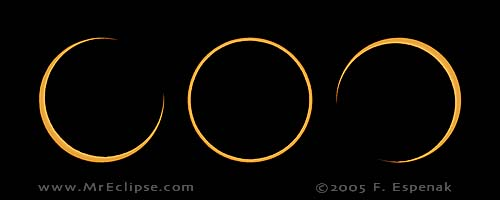
2005 Annular Solar Eclipse
This sequence shows the eclipse just before, during and after annularity.
(click to see more photos)
The "Oddball" Hybrid Eclipse
There's one more type of solar eclipse to mention and its a real oddball. Under rare circumstances, a total eclipse can change to an annular eclipse or vice versa along different sections of the eclipse path. This happens when the curvature of Earth brings different points of the path into the umbral (total) and antumbral (annular) shadows, respectively. Hybrid eclipses are sometimes called annular/total eclipses. The last hybrid eclipse was in 2013 and the next one is in 2023.
Solar Eclipse Frequency and Future Eclipses
During the five thousand year period 2000 BCE to 3000 CE, planet Earth experiences 11,898 solar eclipses as follows:
| Solar Eclipses: 2000 BCE to +3000 CE | |||
| Eclipse Type | Symbol | Number | Percent |
| All Eclipses | - | 11898 | 100.0% |
| Partial | P | 4200 | 35.3% |
| Annular | A | 3956 | 33.2% |
| Total | T | 3173 | 26.7% |
| Hybrid | H | 569 | 4.8% |
This works out to an average 2.4 eclipses each year. Actually, the number of solar eclipses in a single year can range from 2 to 5. Nearly 3/4 of the time there are 2 eclipses in a year. On the other hand, it is quite rare to have 5 solar eclipses in a single year. The last time it happened was in 1935 and the next time is 2206. Typically there is 1 total eclipse every 1 to 2 years. Although it is possible to have 2 total eclipses in a single year, it is quite rare. Examples of years containing 2 total eclipses are 1712, 1889, 2057 and 2252.
The table below lists every solar eclipse from 2021 through 2040. Click on the eclipse Calendar Date to see a global map showing where the eclipse is visible from. The Eclipse Magnitude is the fraction of the Sun's diameter covered by the Moon at greatest eclipse. For total and annular eclipses, this value is actually the ratio of the apparent diameters of the Moon to the Sun. The Central Duration lists the duration of totality or annularity at greatest eclipse. The link produces a table of geographic coordinates of the eclipse path. The last column is a brief description of the geographic regions of eclipse visibility. The descriptions in bold are for the paths of total or annular eclipses.
| Eclipses of the Sun: 2021 - 2040 | |||||||
| Calendar Date | TD of Greatest Eclipse | Eclipse Type | Saros Series | Eclipse Magnitude | Central Duration | Geographic Region of Eclipse Visibility | |
| 2021 Jun 10 | 10:43:06 | Annular | 147 | 0.943 | 03m51s | n N. America, Europe, Asia
[Annular: n Canada, Greenland, Russia] |
|
| 2021 Dec 04 | 07:34:38 | Total | 152 | 1.037 | 01m54s | Antarctica, S. Africa, s Atlantic
[Total: Antarctca] |
|
| 2022 Apr 30 | 20:42:36 | Partial | 119 | 0.640 | - | se Pacific, s S. America | |
| 2022 Oct 25 | 11:01:19 | Partial | 124 | 0.862 | - | Europe, ne Africa, Mid East, w Asia | |
| 2023 Apr 20 | 04:17:55 | Hybrid | 129 | 1.013 | 01m16s | se Asia, E. Indies, Australia, Philippines. N.Z.
[Hybrid: Indonesia, Australia, Papua New Guinea] |
|
| 2023 Oct 14 | 18:00:40 | Annular | 134 | 0.952 | 05m17s | N. America, C. America, S. America
[Annular: w US, C. America, Columbia, Brazil] |
|
| 2024 Apr 08 | 18:18:29 | Total | 139 | 1.057 | 04m28s | N. America, C. America
[Total: Mexico, c US, e Canada] |
|
| 2024 Oct 02 | 18:46:13 | Annular | 144 | 0.933 | 07m25s | Pacific, s S. America
[Annular: s Chile, s Argentina] |
|
| 2025 Mar 29 | 10:48:36 | Partial | 149 | 0.938 | - | nw Africa, Europe, n Russia | |
| 2025 Sep 21 | 19:43:04 | Partial | 154 | 0.855 | - | s Pacific, N.Z., Antarctica | |
| 2026 Feb 17 | 12:13:05 | Annular | 121 | 0.963 | 02m20s | s Argentina & Chile, s Africa, Antarctica
[Annular: Antarctica] |
|
| 2026 Aug 12 | 17:47:05 | Total | 126 | 1.039 | 02m18s | n N. America, w Africa, Europe
[Total: Arctic, Greenland, Iceland, Spain] |
|
| 2027 Feb 06 | 16:00:47 | Annular | 131 | 0.928 | 07m51s | S. America, Antarctica, w & s Africa
[Annular: Chile, Argentina, Atlantic] |
|
| 2027 Aug 02 | 10:07:49 | Total | 136 | 1.079 | 06m23s | Africa, Europe, Mid East, w & s Asia
[Total:Morocco, Spain, Algeria, Libya, Egypt, Saudi Arabia, Yemen, Somalia] |
|
| 2028 Jan 26 | 15:08:58 | Annular | 141 | 0.921 | 10m27s | e N. America, C. & S. America, w Europe, nw Africa
[Annular: Ecuador, Peru, Brazil, Suriname, Spain, Portugal] |
|
| 2028 Jul 22 | 02:56:39 | Total | 146 | 1.056 | 05m10s | SE Asia, E. Indies, Australia, N.Z.
[Total: Australia, N. Z.] |
|
| 2029 Jan 14 | 17:13:47 | Partial | 151 | 0.871 | - | N. America, C. America | |
| 2029 Jun 12 | 04:06:13 | Partial | 118 | 0.458 | - | Arctic, Scandanavia, Alaska, n Asia, n Canada | |
| 2029 Jul 11 | 15:37:18 | Partial | 156 | 0.230 | - | s Chile, s Argentina | |
| 2029 Dec 05 | 15:03:57 | Partial | 123 | 0.891 | - | s Argentina, s Chile, Antarctica | |
| 2030 Jun 01 | 06:29:13 | Annular | 128 | 0.944 | 05m21s | Europe, n Africa, Mid East, Asia, Arctic, Alaska
[Annular: Algeria, Tunisia, Greece, Turkey, Russia, n China, Japan] |
|
| 2030 Nov 25 | 06:51:37 | Total | 133 | 1.047 | 03m44s | s Africa, s Indian Oc., East Indies, Australia, Antarctica
[Total: Botswana, S. Africa, Australia] |
|
| 2031 May 21 | 07:16:04 | Annular | 138 | 0.959 | 05m26s | Africa, s Asia, East Indies, Australia
[Annular: Angola, Congo, Zambia, Tanzania, s India, Malaysia, Indonesia] |
|
| 2031 Nov 14 | 21:07:31 | Hybrid | 143 | 1.011 | 01m08s | Pacific, s US, Central America, nw South America
[Hybrid: Pacific, Panama] |
|
| 2032 May 09 | 13:26:42 | Annular | 148 | 0.996 | 00m22s | s South America, s Africa
[Annular: s Atlantic] |
|
| 2032 Nov 03 | 05:34:13 | Partial | 153 | 0.855 | - | Asia | |
| 2033 Mar 30 | 18:02:36 | Total | 120 | 1.046 | 02m37s | North America
[Total: e Russia, Alaska] |
|
| 2033 Sep 23 | 13:54:31 | Partial | 125 | 0.689 | - | s South America, Antarctica | |
| 2034 Mar 20 | 10:18:45 | Total | 130 | 1.046 | 04m09s | Africa, Europe, w Asia
[Total: Nigeria, Cameroon, Chad, Sudan, Egypt, Saudi Arabia, Iran, Afghanistan, Pakistan, India, China] |
|
| 2034 Sep 12 | 16:19:28 | Annular | 135 | 0.974 | 02m58s | C. America, South America
[Annular: Chile, Bolivia, Argentina, Paraguay, Brazil] |
|
| 2035 Mar 09 | 23:05:54 | Annular | 140 | 0.992 | 00m48s | Australia, New Zealand, s Pacific, Mexico, Antarctica
[Annular: New Zealand, Pacific] |
|
| 2035 Sep 02 | 01:56:46 | Total | 145 | 1.032 | 02m54s | e Asia, Pacific
[Total: China, Korea, Japan, Pacific] |
|
| 2036 Feb 27 | 04:46:49 | Partial | 150 | 0.629 | - | Antarctica, s Australia, New Zealand | |
| 2036 Jul 23 | 10:32:06 | Partial | 117 | 0.199 | - | s Atlantic | |
| 2036 Aug 21 | 17:25:45 | Partial | 155 | 0.862 | - | Alaska, Canada, Arctic, w Europe, nw Africa | |
| 2037 Jan 16 | 09:48:55 | Partial | 122 | 0.705 | - | n Africa, Europe, Mid East, w Asia | |
| 2037 Jul 13 | 02:40:36 | Total | 127 | 1.041 | 03m58s | East Indies, Australia, Pacific
[Total: Australia, New Zealand] |
|
| 2038 Jan 05 | 13:47:11 | Annular | 132 | 0.973 | 03m18s | e North America, n South America, Atlantic, Africa, Europe
[Annular: Cuba, Dom.Rep., Cote d'Ivoire, Ghana, Niger, Chad, Egypt] |
|
| 2038 Jul 02 | 13:32:55 | Annular | 137 | 0.991 | 01m00s | N. & C. America, South America, Africa, Europe, Mid East
[Annular: Colombia, Venezuela, Mauritania, Morocco, Mali, Niger, Chad, Sudan, Ethiopia, Kenya] |
|
| 2038 Dec 26 | 01:00:10 | Total | 142 | 1.027 | 02m18s | se Asia, East Indies, Australia, New Zealand, s Pacific, Antarctica
[Total: Australia, New Zealand, s Pacific] |
|
| 2039 Jun 21 | 17:12:54 | Annular | 147 | 0.945 | 04m05s | North America, w Europe
[Annular: Alaska, n Canada, Norway, Sweden, Finland, Estonia, Russia] |
|
| 2039 Dec 15 | 16:23:46 | Total | 152 | 1.036 | 01m51s | s South America, Antarctica
[Total: Antarctica] |
|
| 2040 May 11 | 03:43:02 | Partial | 119 | 0.531 | - | Australia, New Zealand, Antarctica | |
| 2040 Nov 04 | 19:09:02 | Partial | 124 | 0.807 | - | N. & C. America | |
Geographic abbreviations (used above): n = north, s = south, e = east, w = west, c = central
For an extended version of this table, see: Solar Eclipse Preview: 2015-2030.
The last total solar eclipse visible from the continental USA occured on Aug. 21, 2017. A total solar eclipse was visible from Hawaii and Mexico on July 11, 1991. The next total solar eclipse visible from the USA occurs on and Apr. 8, 2024.
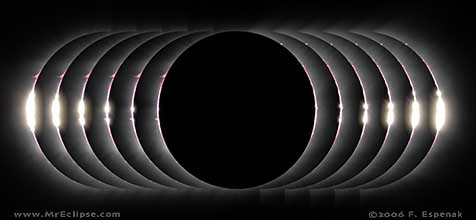
2006 Total Solar Eclipse
This Baily's Beads sequence shows both 2nd and 3rd Contact.
(click to see more photos)


